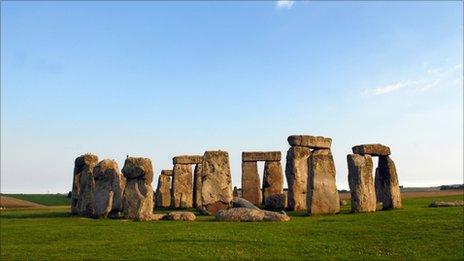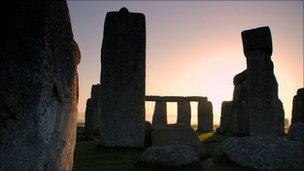Stonehenge rocks definitely came from Wales, but how?
- Published

Questions are being asked about how stones got from Pembrokeshire to the iconic monument in Wiltshire
New research has cast fresh doubt on the journey which the Stonehenge Bluestones took from Pembrokeshire to the site of the pagan monument.
Since the 1920s, geologists have strongly suspected that the 'spotted dolerite' Bluestones, which form Stonehenge's inner ring, originated from Mynydd Preseli in the north of the county.
However, whilst the new findings have also linked a second type of stone - rhyolites - to the area, they call into question how the stones arrived in Wiltshire.
Perceived wisdom had it that Stone Age man transported the giant slabs via raft, up the Bristol Channel and River Avon.
But as Pont Saeson, the location of the new match, is to the north of the Preselis, some believe its unlikely that they would have been able to navigate the terrain in order to get the enormous rocks to the coast.
An alternative theory was that nature drove the stone to Stonehenge, in the path of an Ice Age glacier, although the absence of any other Welsh rock in the region seemed to have ruled out the possibility.
'Hugely significant discovery'
Yet Dr Richard Bevins, a geology expert from the museum which collaborated in the research by Aberystwyth and Sheffield Universities, believes it may now be time to revisit the idea.
"If humans were responsible then an alternative route might need to be considered. However, if, as some believe, the stones were transported by the actions of glacier sheets during the last glaciation, the Pont Saeson discovery will need appraising in the context of this hypothesis."
"Matching up the rock from Stonehenge with a rock outcrop in Pembrokeshire has been a bit like looking for a needle in a haystack, but I've looked at many if not most outcrops in the Mynydd Preseli area.
"We are however, confident that we have found the source of one of the rhyolites from Stonehenge because we've been able to make the match on a range of features not just a single characteristic. Now we are looking for the sources of the other Stonehenge volcanic and sandstone rocks".

The inner ring of stones have been linked to the Preseli area of south west Wales since the 1920s
Dr Bevins' team are able to say so categorically that they've discovered the source of the rhyolites, thanks to a range of laser mass spectrometry techniques, which analyse both the chemical composition of the rock and the micro-biology present when it was formed.
The combination of the two provides an almost unique signature for rocks only found in the Pont Saeson area.
But the new match does not explain the absence of any other Welsh Bluestone in the Stonehenge area, if indeed glaciation was responsible for carrying them there.
Prof Mike Parker Pearson, from Sheffield University, called it "a hugely significant discovery which will fascinate everyone interested in Stonehenge".
"It forces us to re-think the route taken by the Bluestones to Stonehenge and opens up the possibility of finding many of the quarries from which they came.
"It's a further step towards revealing why these mysterious stones were so special to the people of the Neolithic."